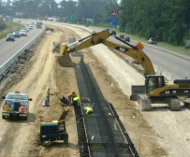8/15/2012
Texas Study Finds Wider Highways Safer, Virginia Narrows RoadsTexas Transportation Institute concludes wider roads are safer, while Virginia narrows lanes so it can impose tolls on Interstate 95.

An forthcoming study by the Texas Transportation Institute (TTI) found highway widening projects increased safety in the Lone Star State. The Texas Department of Transportation (TxDOT) tasked TTI to evaluate a broad range of safety improvements undertaken by the agency, but researchers decided to offer a preview last week of one of TxDOT's most effective programs.
"The agency's roadway widening initiative has been a tremendous success, both for increasing safety on Texas highways and potentially saving billions of dollars associated with fatal crashes and sustained injuries," TxDOT Executive Director Phil Wilson said in a statement.
A total of 1159 miles of highway shoulders were added to narrow, two-lane highways. A comparison of accident rates three years before the improvements and three years after showed fatalities were reduced by an average of 44 per year, according to TTI. Another TxDOT project spent spent $29 million on 37 widening projects that yielded an average reduction of five fatalities per year.
A similar study by the University of California published in 2008 concluded, "Collision rates diminish with an increase in shoulder width" (view study). Given the results, TxDOT said it would continue widening roads.
Virginia, on the other hand, just signed a $1 billion project to narrow lanes on Interstate 95 between Garrisonville and Edsall road outside Alexandria. Governor Bob McDonnell (R) last week held a groundbreaking ceremony for the conversion of the I-95 high-occupancy vehicle lanes into a toll road owned by the Australian firm Transurban. Three reversible toll lanes will be squeezed into the space that currently provides two reversible lanes that are twelve feet wide with generous ten-foot shoulders on each side. This will be done by narrowing the lanes to eleven feet wide with shoulders narrowed in some areas to just two feet on one side and nine feet on the other.
The project includes provisions for expanded bus service using the lanes. A typical transit bus is 8.5 feet wide, with side-view mirrors extending another foot in each direction, leaving just half-an-inch of space. A 1996 Transportation Research board study recommended traffic lanes used by buses should be no narrower than twelve feet wide.


